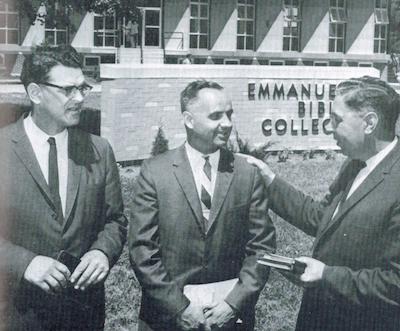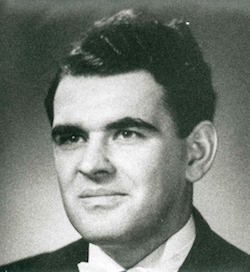This year, as we celebrate Emmanuel’s eightieth anniversary, we will be posting monthly articles on the history of the College.
April 16, 2020
In the late 1950s, the future of Emmanuel Bible College was unclear. Since 1943 it had been operating in the Metcalfe mansion on Ahrens Street in Kitchener, and as time went on the aging home became increasingly problematic for the school. Further questions arose when President Ward M. Shantz, who had been so instrumental in the school’s operations from its very beginning, resigned from his position.
There was talk of a merger with the Free Methodist school Lorne Park College, and Emmanuel’s Board decided to move ahead with this plan. However, the annual conference of the United Missionary Church, the denomination to which Emmanuel belonged, disapproved of the merger, and it never came to fruition. Instead, the school pursued a new plan under the leadership of Shantz’s replacement, Bruce Wideman.
It was decided that Emmanuel would move from Ahrens Street to the Beulah Grove campground, which had been used for revival meetings since the 1920s. The move to this new campus would require the construction of new buildings. In this matter President Wideman, in the words of Eileen Lageer, “proved himself to be a builder of buildings as well as of youth,” being involved personally in these construction projects.[1] First, there was the construction of a home on the corner of Weber Street and Fergus Avenue, which still stands today. This home was to house Emmanuel’s president.
Next came the construction of the Administration Building, which had a distinctive and attractive architectural style. This building was the primary locus of academic activity, including, among other rooms, an assembly hall, the library, and several classrooms.
Finally, President Wideman led the construction of a residence building, named after P. G. Lehman, an early faculty member. In 1968 a second residence was added and adjoined to Lehman Hall by the Common Lounge, which was a favourite social area for students. Through all of this, the Tabernacle, the partially enclosed structure used for the camp-meeting services, remained intact.
Emmanuel officially moved to its new home in 1964. Considerable money and effort had been invested into the project, and under Wideman’s leadership, the investment paid off tremendously. Enrollment increased, and in 1972, when Wideman left his position to return to pastoral ministry, there were 117 students, a drastic increase from the 35 who gathered at the Ahrens Street house for classes in early 1960.
Thus, President Wideman, the “builder” president, helped construct a solid future for Emmanuel during a time of uncertainty. The second residence building was named in his honour, and his legacy lives on in Emmanuel’s continuing resolve to respond to ever-shifting realities and prepare leaders for the church.
The featured photographs shows, from left to right, Bruce Wideman, John Pipher, and Ward M. Shantz standing in front of the Emmanuel Bible College sign and Administration Building in July 1964. Photograph taken by the Kitchen-Waterloo Record and reprinted in Kevin Oates, 60 Years of “God with Us” (n.p.: n.d.), 37.
[1] Eileen Lager, Merging Streams: Story of the Missionary Church, ill. Leah Gillard (Elkhart, IN: Bethel: 1979), 152. For more source material used in this article, see Oates, 29–41, 73; Lageer, Merging Streams, 151–53.


